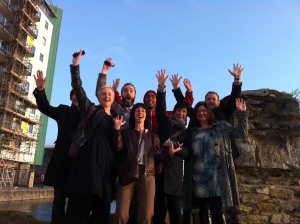Tying into the topic of personal learning networks (PLNs), my previous post highlighted the fact that I was about to attend PELeCON, or rather the 8th Plymouth e-Learning Conference, where I was looking forward to meeting up with people whom I consider to be a significant part of my PLN. I attended the conference last year, where I’d experienced its friendly, energetic buzz so, in spite of a 9hr journey, there was never any question of me not returning again this year. And, I have to say that I wasn’t disappointed; not only did I meet familiar faces en route, Doug Belshaw and Steve Bunce, but I received a warm welcome from Catherine Cronin and Mary Loftus, part of the the Irish contingent who had sensibly travelled the evening before, and all of whom were congenial in making further introductions to what turned out to be another terrific conference. Equally, it seems that others who attended the conference share similar sentiments too.
#pelc13 fine 3 days at Pelecon – nice bunch of open, knowledgeable people there to debate discuss & drink thanks @timbuckteeth
— Donald Clark (no flags, no hashtags) (@DonaldClark) April 12, 2013
The reason for such enthusiastic bonhomie, it seems to me, is that PELeCON is not just a conference. By combining networked and online presence with an annual physical event, PELeCON is more akin to what James Paul Gee would call a “passionate affinity space” than a common-or-garden conference.
A passionate affinity space, and the learning that goes on in it, requires some people associated with the space to have a deep passion for the common shared endeavour. It does not require everyone to have such a deep passion, but it does require them to recognize the value of that passion and respect it, in some sense.
Quite right. I’d like to think that not only have I developed a valuable personal learning network, but through PELeCON, I’ve found a great “passionate affinity space” in which to learn as well. The satisfied smiles on the journey back to Ireland would suggest that I’m not the only one who thinks this way.

Back: Steve Warburton, Doug Belshaw, Zak Mensah, Mark Smithers
Front: Mary Loftus, Helen Crump, Catherine Cronin, Pamela O’Brien
Ok, but what did I learn?
After, attending a delightful first session in which Steve Bunce engagingly got everyone finger knitting in order to demonstrate possible approaches to involve children in computer programming, I made my way to listen Mike John’s presentation, “Talking with lecturers: What happened to Web 2.0?”. I was especially keen to hear of his observations in relation to the uptake of Web 2.0 amongst university lecturers as this chimes with my own interests and recent research. The thrust of the presentation was in terms of the gap that exists between the hype surrounding Web 2.0 and the actual take-up of such networked and participatory practices amongst lecturers. Citing examples of activity levels in everyday applications, he pointed out that Web 2.0 gets few ticks from lecturers in their professional practice, and concluded that within higher education, Web 2.0 “is a minority sport; it’s not a mainstream activity”. All very interesting observations, but as Donald Clark noted, the presentation relied largely on the presenter’s observations and not on actual data.
In her excellent presentation entitled “Enacting Digital Identity”, Catherine Cronin called attention to the fact that “different contexts have different legitimacy practices” and highlighted the dis-joint between academic learning practices and networked learning practices (see slide 44).
The theme of digital identity, or online presence, or personal online branding even, re-occurred on the final day of the conference in Joyce Seitzinger’s practical keynote, in which she referred to the term “cloud academics” and talked about her emerging role, akin to a “personal digital coach”, with its focus on instilling networked practice for personal learning, teaching and research amongst lecturers.
Then, giving the final keynote of the conference, Donald H Taylor, with his insight from industry, painted the big picture. Flagging the enormity of impending disruption and change soon to be wrought upon higher education as venture capital seeks optimum return, he plotted pace of change axes to locate those either too tardy, or just plain unwilling, to change and to mark them as being somewhere on the road to “comfortable extinction”. A memorable phrase indeed, and one that made me think back to the lecturers that Mike John observes on the other side of the gap, to the different identities that must be enacted within academic and networked practice and to the “cloud academics” that Joyce Seitzinger’s presentation brought forth.
All of the PELeCON keynotes captured something of this air of change, but more importantly, they all went some way to laying out ways in which education might effectively meet these future challenges, be it Grainne Conole’s advocacy of learning design, Doug Belshaw’s belief in open badges as a “trojan horse”, Steve Bunce’s knitting hypotheses or Karin George‘s hands-on leadership.
Finally though, the air of change came to PELeCON itself when Steve Wheeler announced in the closing session that the “passionate affinity space” that has become PELeCON will no longer be found in Plymouth, as the conference is looking for a handier location and is to henceforth become the Professional Enhanced Learning Conference. All of which can only be a good thing, if it allows more people to access the event and to share the passion. And I’m sure that wherever PELeCON lands, it will still be a unique friendly event with excellent keynotes speakers and ever topical presentations. 🙂
References:
Gee, J. P. and Hayes, E. R. (2011). Language and Learning in the Digital Age. Taylor & Francis. Kindle Edition.

This work is licensed under a Creative Commons Attribution-NonCommercial-ShareAlike 3.0 Unported License.

